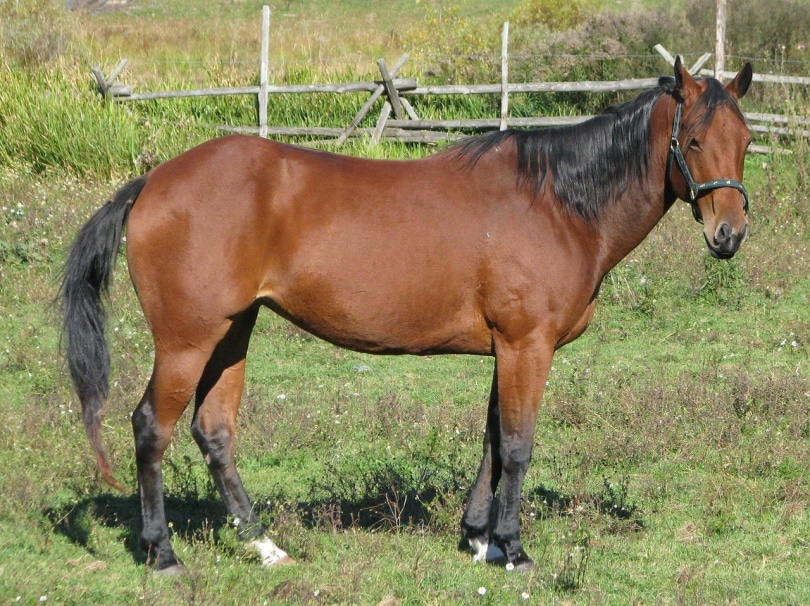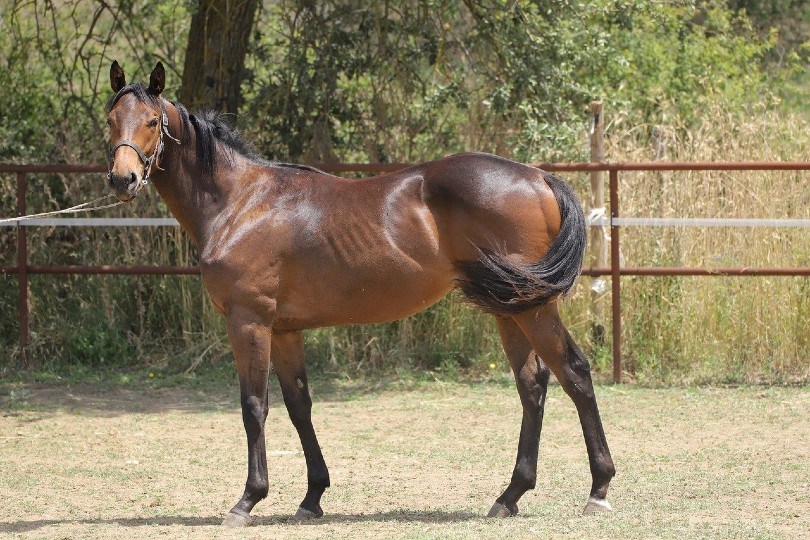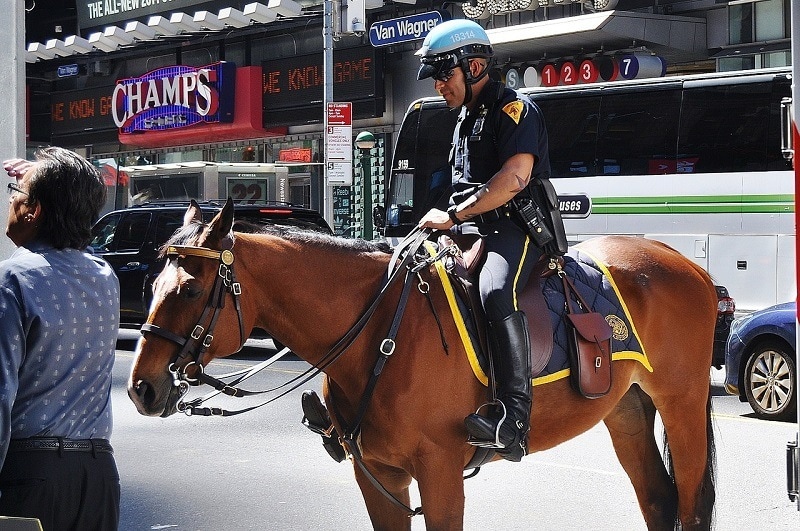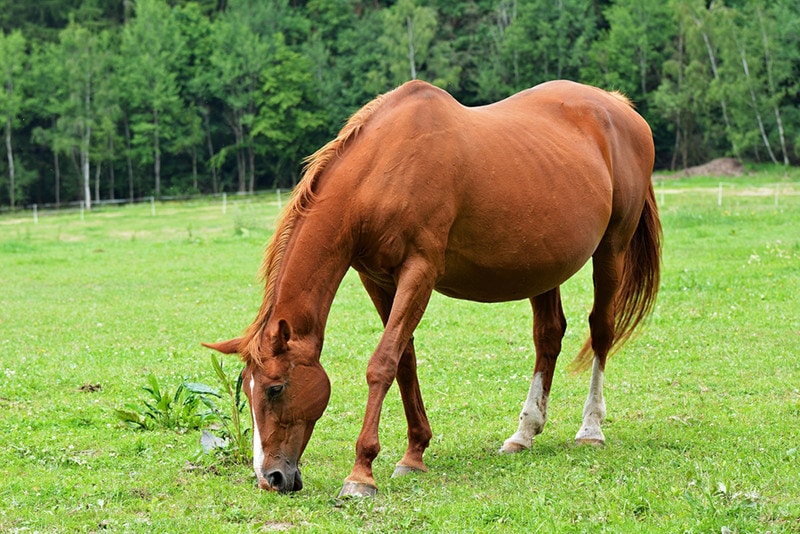
Back in the old days, we relied on horses for everything from transportation to agriculture. Once modern advancements took off, the need for horses declined drastically. However, police officers today still rely on horses to patrol certain parts of towns or cities. Have you ever wondered what types of horses mounted police officers use?
The truth is, it depends on the area. Different countries use different breeds. Let’s learn a bit about these horses and why they are excellent matches for mounted police.
The 8 Horse Breeds Police Use
1. Percheron

The impressively stout Percheron is a horse hailing from France. They are known for their muscular elegance and work ethic. It’s no wonder that they are top choices for mounted police.
History
Historically, Percherons were used to pull enormous amounts of weight. They are impressive in structure, making them ideal for weight-pulling competitions and laborious tasks.
Physical Traits
Percherons are stunningly well-muscled, standing 16 to 17 hands high. They weigh between 1,900 and 2,100 pounds and have thick curved necks and broad, burly chests. Percherons can be in several colors, most commonly black and gray.
Personality
Percherons are charming horses with a willingness to learn and work. Because they are so receptive and gentle, it makes them ideal candidates for police.
2. Belgian
As a shorter stout draft breed, the Belgian, or Belgian Draft horse, has an excellent work ethic and a calm temperament. Because of their desire to please, they do very well in areas where mounted police monitor activity.
History
The Belgian Draft horse is the strongest of all the draft breeds being solid and capable of learning just about anything. Humans have relied on them for work-related labor for several hundred years.
Physical Traits
Belgium horses are very stout, muscular horses that stand roughly 17 hands high. They have gorgeous leg feathering and typically come in chestnut, sorrel, or blonde.
Personality
Belgium horses are very mild and gentle. They make excellent candidates for working with people due to their docile, friendly demeanor.
3. Quarter Horse

The American Quarter Horse is a widespread breed—and for a good reason. They come in handy for all sorts of things, from everyday riding to competing in shows.
History
The Quarter Horse is an American horse bred in the 1600s for short spurts of speedy movement. Even though they work well for these tasks, they have earned their proficiency in many areas.
Physical Traits
Quarter Horses are short and stocky, with perfect builds for running. Quarter Horses stand roughly 15 hands high. They come in quite a few color variations, such as sorrel, roan, palomino, black, gray, brown, chestnut, dun, grullo, buckskin, and dun.
Personality
Quarter Horses are eager to please and curious. They like to learn new things, which makes them excellent candidates for training.
- Related Read: 9 South American Horse Breeds (with Pictures)
4. Thoroughbred

Initially, Thoroughbreds were developed for tasks like racing and jumping. But as time passed, the value of these horses rose tremendously, since they are multi-skilled.
History
Thoroughbred horses are used so frequently throughout history to create different breeds that we know and love today. Thoroughbreds have such desirable traits that we look for, serving many areas of expertise.
Physical Traits
Thoroughbreds stand approximately 16 hands high. They come in five acceptable coat colors: black, chestnut, gray, bay, and white. White markings on the legs and face are also .
Personality
Thoroughbreds are considered hot-blooded horses, which means that they are spirited, energetic, and keenly sharp. They are not for the faint of heart, making them sometimes challenging to train but rewarding at the same time.
5. Dutch Warmblood
Dutch Warmbloods are best known for roles in showjumping and related tasks. Their quickness and steady gait allow them to perform with accuracy and precision.
History
This breed has roots dating back to pre-World War II. It was melded from Dutch breeds—the Groningen and Gelderlander.
Physical Traits
These horses are muscular and tall, standing roughly 15 to 16 hands high. They are typically brown, black, gray, or chestnut with white markings.
Personality
Dutch Warmbloods are extremely intelligent and eager to go, go, go! So, it’s no surprise that they make terrific mounted police horses for their upbeat, positive demeanor.
6. Tennessee Walker

Tennessee Walkers are known for their quick-gaited step and well-rounded trot. They provide a smooth, seamless riding experience for riders, making them ideal picks for mounted police.
History
The Tennessee Walker was initially developed in the United States to work on farms and plantations. Many horses such as Thoroughbreds, Standardbreds, and Canadian Pacers came together to form this breed.
Physical Traits
These horses typically stand between 14 and 15 hands high. Any color within the equine spectrum is acceptable.
Personality
Because of their soft, sweet demeanor they are well-suited for all experience levels and age groups.
7. Hanoverian

The Hanoverian is considered one of the most accomplished horses of all warmbloods. Because of their grand athleticism and good temperament, they are selected for mounted police duties on many teams.
History
These warm-blooded horses originated in Germany. For years, they competed in equestrian Olympic games and other competitions.
Physical Traits
Hanoverians are very elegant and sturdy. They can be quite tall, measuring between 15 and 17 hands high. Hanoverian horses come in all solid colors, but they cannot have any markings of white or other patterns.
Personality
Hanoverian horses are described as bold, courageous, and willing to work. Their quickness and charm help them adapt to any working situation.
8. Spotted Saddle Horse
Spotted Saddle Horses have a remarkably steady gait for a great riding experience. Their smooth trot allows officers to ride without issue—so it’s no wonder that these graceful equines are often chosen for mounted police duties.
History
These horses are the result of crossing Tennessee Walker horses with Spanish ponies. The combination created a gentle, exceptionally smooth horse with a balanced body.
Physical Traits
These horses range from 14 to 16 hands high. As the name implies, the Spotted Saddle Horse is typically two bold color combinations. They can be any color or pattern except pinto.
Personality
These horses are widely known for being extraordinarily well-mannered and friendly. Since they are calm and receptive, they make excellent candidates for any type of training work. Their stamina also helps in this arena.
Mounted Police: What Is the Job All About?
Using horses in modern culture can seem outdated to some. You might see one or two pulling a carriage in a snowfall setting or see people leisurely out riding for fun—but you rarely see one in the line of duty. However, mounted police have a deep need for equine coworkers still today.
So, why might someone elect a horse for duty? Mounted police ride horses for a few different reasons. It can definitely depend on the area, population, and situation. Mounted police horses are skilled in the following situations:
Thankfully, our horse friends are incredibly easy to train and work with. Certain breeds make better mounted police horses than others. Sometimes it also depends on the type of police work they will be helping perform. Certain horses do better on specific types of terrain. One might work better in the rough rural territory; another would work better on a city street.
Temperament says a lot also about what horse works better where. If you have a calm, docile horse, they might work better in a high-intensity, stressful situation. Whereas if you have a more relaxed environment, you might be able to have a horse that’s just a tad more high-strung.
Let’s learn a little bit about the most popular choices among mounted police. The list doesn’t end here. Lots of horses are called upon to help officers all over the world. But these eight choices are excellent candidates that are most often chosen.

Popular Areas for Mounted Police
You can find mounted police in practically every country in the world. Interestingly, you can find mounted police riding horses, but camels are also a popular choice in some countries.
Some mounted police stations include:
Several other places have mounted police in certain situations, too.
Conclusion
It’s impressive to reflect on just how much horses have helped humanity thrive since their domestication. Although their roles in our lives have changed drastically, they are still very needed today. Horses help mounted police forces from every continent monitor, patrol, and serve many areas.
While this doesn’t complete the long list of horses that assist law enforcement, you now know what type of horse traits they look for in their equine partners.
Related Read:
Featured Image Credit: Arturo Rey, Unsplash










